
Unlock Global ABM at Scale — Madison Logic strengthens ABM reach with Connected TV and Audio expansion globally. Learn More
Unlock Global ABM at Scale — Madison Logic strengthens ABM reach with Connected TV and Audio expansion globally. Learn More

Madison Logic’s SVP of Product, Liz Ronco, headed to San Francisco to deliver a sold-out session at HubSpot’s INBOUND 25 on “AI-Powered ABM: Revolutionize Your Marketing Strategy.”
While her session highlighted practical strategies for AI-powered account-based marketing one theme stood out across INBOUND 25: marketing is undergoing a fundamental shift. AI is no longer just another tool in our toolkit—it’s reshaping how we create, connect, and convert. For marketers and brands alike, the question isn’t if you should embrace AI, but how you’ll evolve alongside it.
INBOUND 25 was an incredible event full of talented marketers, big ideas, and inspiring conversations. Read on for our key insights from the event, as well as a recap of Liz Ronco’s session.
At INBOUND 25, HubSpot CEO, Yamini Rangan, highlighted how the era of AI has caused marketing to shift in ways that demand new strategies and thinking. Traditional marketing assumptions no longer hold—buyers’ behaviors and expectations are changing faster than ever, and marketers need to meet them where they are, not where we hope they’ll be.
Rangan emphasized two major shifts in particular:
But what does this really mean for marketers? Awareness has scattered. Buyers no longer start their journey on your website—they are everywhere, consuming content in new ways and on new marketing channels:
Growth strategies built for the AI era need to match this behavior, focusing on podcasts, CTV, social ads, and high-quality, personalized content that connects on a human level and encourages engagement beyond an impression metric.
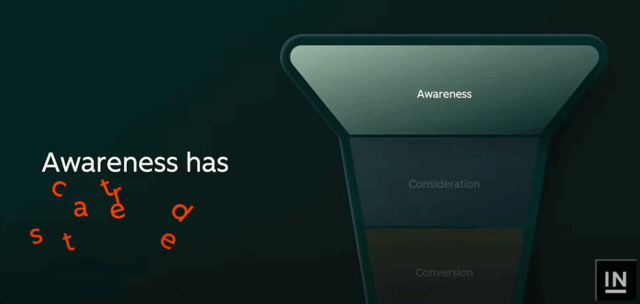
The role of artificial intelligence in account-based marketing goes far beyond efficiency gains—it’s becoming a core driver of modern ABM strategies. With an increasing focus on delivering highly personalized experiences across multiple channels, identifying and prioritizing the right accounts, and engaging buyers where they actually spend their time, AI amplifies these capabilities—enabling marketers to scale precision and relevance while maintaining the human connections that drive results.
Much like the broader adoption of AI in B2B marketing, marketers are optimistic about the value and opportunities AI brings to ABM. This optimism is reflected in data from a 2025 Harris Poll survey with Madison Logic:
This data highlights how marketers view AI as a tool for enablement—not a replacement. By automating repetitive tasks and scaling personalization, AI enables teams to focus on strategic, high-value work that improves customer journeys and drives measurable business impact.
Liz Ronco dove deeper into how to leverage AI to transform ABM programs for greater impact and measurable results while emphasizing the importance of maintaining human-to-human connections. Here are the key takeaways from her session and how marketers can put them into action:
B2B marketing has changed because buying has changed. Buying committees are expanding rapidly—what used to be six to ten decision-makers now often involves 14–23 stakeholders. At the same time, younger decision-makers are becoming increasingly influential: over 70% of those decision-makers are millennials or Gen Z, digital natives who have spent most of their lives online.
This new generation of B2B buyers doesn’t just consume information differently; they buy differently. Nearly 60% say they have little or no interest in speaking directly to a sales rep That means buying decisions are increasingly made in the channels they already use, often without any vendor interaction.
And what do those channels look like? Here’s a typical “day in the life” for the typical B2B buyer:
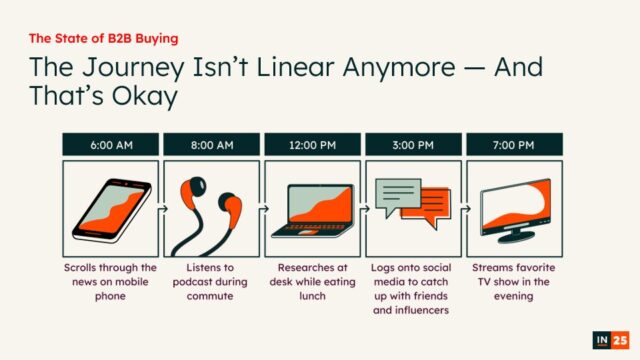
Multiply that behavior across 14-23 stakeholders in a buying group, and across dozens or even hundreds of target accounts. Your buyers aren’t moving neatly through a funnel—they’re navigating a constant stream of information, across multiple channels, often at the same time.
While this may look chaotic, chaos isn’t the problem—ignoring it is. Human behavior is messy and fragmented, and no manual process can keep up. This is exactly where AI steps in to connect buying signals, decode the noise, and help marketers respond with precision at scale.
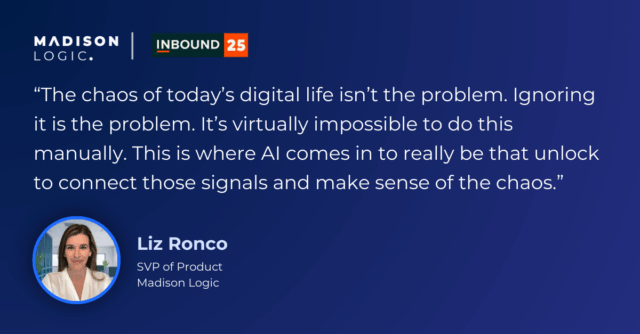
Marketing teams have more tools than ever, but the real bottleneck isn’t technology—it’s human behavior. While most marketers are excited about AI, 62% struggle to implement it effectively, citing lack of strategy as a primary barrier. Overcoming this gap requires more than just access to tools; it demands the right strategy, skills, and processes to ensure AI is actually adopted and put to work in marketing.
People naturally stick with what feels familiar, even when old habits are inefficient or outdated. Many marketers approach AI with uncertainty or fear—and concerns about job security, losing control, or making mistakes with new technology can slow adoption. In fact, 47% of marketers fear AI will eliminate more jobs than it will create. Change requires more than just instructions; it requires building trust, creating safe spaces for experimentation, and showing how AI can support teams rather than replace them.
In practice, teams can encourage AI adoption and build trust by:
AI should be approached as a force multiplier rather than a replacement. Human creativity, empathy, and judgment remain essential—AI amplifies these strengths rather than replacing them. The companies that will succeed in the AI era are those that focus on behavioral change and trust, integrating AI into their workflows to support, rather than dictate, how teams operate. Technology alone doesn’t solve problems; people do—but AI can make their efforts smarter, faster, and more effective.
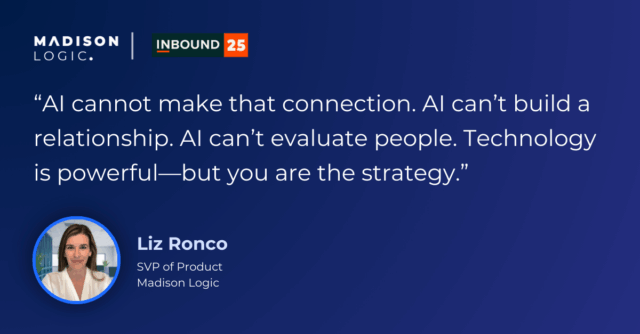
In today’s non-linear buyer journey, winning attention requires more than reach—it requires recognizing buying signals and responding with the right message at the right moment.
AI makes this possible by monitoring intent signals across target accounts—like a newsletter sign-up, webinar registration, or demo request—and surfacing what matters most. This allows marketers to prioritize accounts, engage individuals at the right time, and deliver messages that resonate. But these signals are only powerful when they’re built on a strong ABM foundation:
Once this foundation is set, the real challenge is capturing attention in a way that drives decisions. While using generative AI can help surface signals and prioritize accounts, marketers still need to ask, what actually sticks out above the noise? That’s where the Spark, Support, Socialize framework comes in:
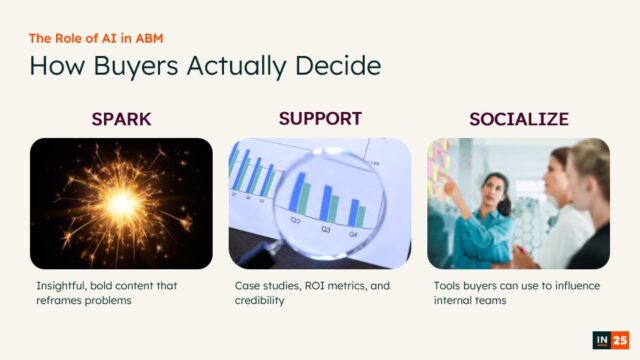
The sweet spot comes from combining these elements with AI-driven insights. For example, imagine a software company targeting mid-market finance teams. Using their ICP, buyer personas, and TAL, AI helps identify high-priority accounts where multiple decision-makers are showing early intent—such as downloading reports, attending webinars, or visiting key product pages. Once these signals are identified, the next step is determining how to engage these buyers effectively:
By layering AI insights on top of a structured ABM foundation, marketers can deliver the right message to the right buyer at the right time and transform the funnel from a rigid path into a living engine that responds to signals, captures attention, and maximizes ABM engagement.
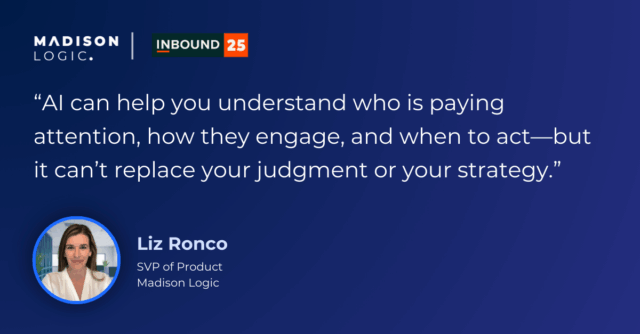
AI only creates value when it’s connected to a clear blueprint. With a plan, AI can react in real time—delivering the right message, in the right channel, at the right moment—which often makes the difference between waiting and winning.
But what exactly does that plan look like?
Before AI can truly drive impact, teams need to understand how adoption typically unfolds. Transformation doesn’t happen overnight—it’s a gradual journey. Most organizations start small, testing AI in limited areas, then progressively scale as they gain confidence and results.
AI adoption typically unfolds in three stages:
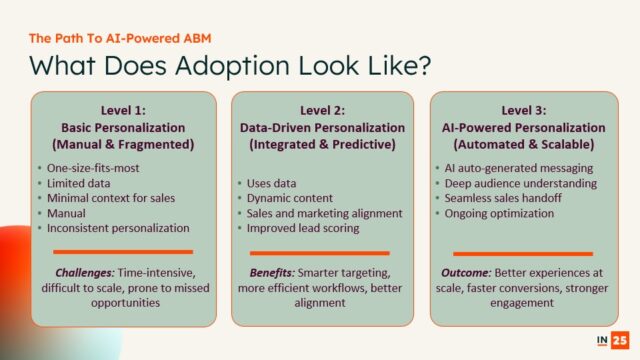
Reaching Level 3 doesn’t happen all at once; even moving from Level 1 to Level 2 can unlock significant gains in efficiency, relevance, and engagement. (Most teams aren’t fully at Level 3 yet. If you are, congratulations, you’re probably a unicorn.) And keep in mind the human aspect when it comes to implementing AI successfully. As Liz Ronco said:

To put AI into action, begin small—test one nurture flow, experiment with trigger-based messaging, or score contacts and content dynamically. The key is starting with experiments that generate momentum, then gradually scaling across accounts, campaigns, and channels. By intentionally progressing through these levels, organizations can turn chaotic signals into a structured, actionable system that drives measurable revenue impact.
As Liz Ronco emphasized at INBOUND 25, AI isn’t a shiny tool or a replacement for human judgment—it’s the key to unlock your ABM strategy from plan to action.
Tools like Madison Logic’s SmartReach™ amplify what marketers do best: supercharging account personalization and outreach by transforming real-time buyer insights into AI-driven communication scripts for quality lead engagement. And because buyers are consuming content everywhere, solutions like Madison Logic’s ABM Audio Advertising and ABM Connected TV extend your ABM strategy across the channels where decision-makers are actually spending their time.
Want to turn signals into revenue? Download our ABM Playbook or request a demo to see how Madison Logic can help you embrace the non-linear buying journey and build an AI-powered ABM strategy that wins.